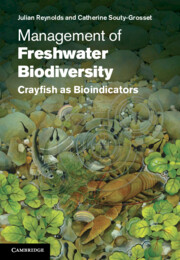Book contents
- Frontmatter
- Contents
- Preface
- Acknowledgements
- Introduction: Biodiversity in freshwater systems, and the key roles played by crayfish
- Part I The present situation of crayfish in world freshwater ecosystems
- 1 Crayfish in the decapod lineage, their natural distribution and their threatened status
- 2 Why are crayfish, among freshwater decapods, considered pivotal in freshwater ecosystems?
- 3 Crayfish as prime players in ecosystems
- 4 Human-mediated threats to crayfish survival
- 5 Crayfish exploitation systems
- Part II Applying science to conservation management
- Part III Knowledge transfer for successful crayfish management
- References
- Glossary
- Index
- Scientific and common English names of well-studied crayfish featured in this book
- Common English and scientific names of well-studied crayfish featured in this book
- Plate section
4 - Human-mediated threats to crayfish survival
environmental degradation, climate change and translocations
from Part I - The present situation of crayfish in world freshwater ecosystems
Published online by Cambridge University Press: 05 December 2011
- Frontmatter
- Contents
- Preface
- Acknowledgements
- Introduction: Biodiversity in freshwater systems, and the key roles played by crayfish
- Part I The present situation of crayfish in world freshwater ecosystems
- 1 Crayfish in the decapod lineage, their natural distribution and their threatened status
- 2 Why are crayfish, among freshwater decapods, considered pivotal in freshwater ecosystems?
- 3 Crayfish as prime players in ecosystems
- 4 Human-mediated threats to crayfish survival
- 5 Crayfish exploitation systems
- Part II Applying science to conservation management
- Part III Knowledge transfer for successful crayfish management
- References
- Glossary
- Index
- Scientific and common English names of well-studied crayfish featured in this book
- Common English and scientific names of well-studied crayfish featured in this book
- Plate section
Summary
We have seen how crayfish are important elements in many different kinds of freshwater ecosystem, often acting as keystone species and enhancing biodiversity through controlling the abundance of many other organisms in the community. However, the all-pervading handiwork of humans has threatened their existence in many ways. In this chapter we look at the negative impacts of environmental deterioration and the introduction of alien species and, in the next, at exploitation.
The Millennium Ecosystem Assessment (MEA; proposed in 2000 and initiated in 2001) noted that different environmental pressures were important on each continent. Among regions containing crayfish, water quality was especially poor in Europe (Füreder et al., 2006), whereas on other continents water shortages, wetland conversion, droughts and fire were among the significant pressures affecting crayfish. In Europe, the few crayfish species were formerly distributed more widely, and were found in many lakes, rivers and brooks until the beginning of the twentieth century, but their distribution has shrunk and become fragmented. The threats considered most important to indigenous European crayfish are crayfish plague, the continued spread of non-indigenous signal, red swamp and spiny-cheek crayfish (Holdich, 2003), and the illegal exploitation and trading of crayfish. Threats considered of lower or local importance include habitat management-related parameters such as predators and habitat alterations, and watercourse alteration – damming, abstraction and the drying out of habitats through drainage (Füreder et al., 2006).
- Type
- Chapter
- Information
- Management of Freshwater BiodiversityCrayfish as Bioindicators, pp. 83 - 110Publisher: Cambridge University PressPrint publication year: 2011
- 1
- Cited by



